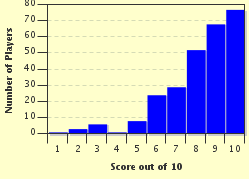Quiz Answer Key and Fun Facts
1. In the 1500s, fur hats became very popular in Europe. This created a huge demand for imported pelts from which hard-working and industrious animal from Canada?
2. Jeanne Sauve was the first Canadian female to hold what important position?
3. This man was Canada's Prime Minister during WWII. What is his name?
4. Which animal, hunted almost to extinction, was once the main source of food for the Blackfoot Indians of Canada?
5. Including the amateur era, which of the following two teams were Canada's first ice hockey teams to win a Stanley Cup Championship?
6. What type of 'footwear', used specifically for winter travel, was invented by Canada's first native peoples?
7. The world-famous Canadian, Rick Hansen, travelled around the world to raise money for spinal cord research. What made his trip extremely difficult?
8. From 1920-1933, seven well known Canadians were known as "The Group of Seven". What was this group famous for doing?
9. The name "Canada" was taken from the same Iroquois Indian word "canada". What does "canada" mean when translated to English?
10. In 1917 during the first world war, a Canadian city was flattened when two ships collided in the harbour, causing a large fire which then caused an enormous explosion. Which city am I talking about?
Source: Author
mayneeyak
This quiz was reviewed by FunTrivia editor
NatalieW before going online.
Any errors found in FunTrivia content are routinely corrected through our feedback system.

